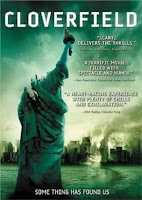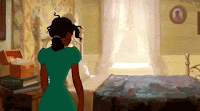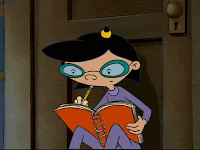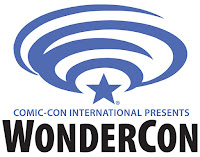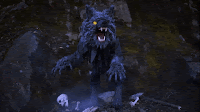Holy crap, things have been a mess for me. Copyedits on two different projects and notes on two other projects. My mom visiting. Me getting sick. My partner getting really sick. My beloved Goblin needed eye surgery, with two appointments leading up to that. Oh, crap, and WonderCon was in there too.
And meanwhile, the ranty writing blog sits neglected for almost two months. Unloved. Gathering dust…
Yes. Very sad. Anyway…
I got a request on an older rant about two months back, so I’m going to skip my planned topic and answer that. Because I read all the comments. And I answer all the questions. Plus let’s face it, it’s been so long you’ve forgotten what I’d said I was going to talk about anyway, didn’t you?
Jared wanted to know–
“How do you handle a character ‘thinking’ or carrying on with an inner monologue? With my current story my main character has a good bit of that going on and I seem to be stuck on treating it like regular dialogue. Does that take your reader out of a story?”
Okay. This is going to be a bit loose on hard facts because there’s a few different ways to approach this and there’s no right way to do something in fiction. I think there’s definitely wrong ways to do thing, but they’re pretty few and far between. Usually. Some people are very creative.
To begin, how we do thoughts in fiction depends a lot on what format our story’s taking. F’r example…
In first person, the narrative is essentially already in my character’s head. In a way, everything is their thoughts. The whole story. So even when there’s no dialogue, we’re aware that it’s still the character’s voice and viewpoint. Just like this. None of this is written as dialogue, and you understand I’m not speaking, but at the same time you also immediately understand all of this is my thoughts about writing. So in first person, I don’t have to do anything special to signify my characters thoughts because… well, it’s all thoughts. Done.
Plus side, thoughts in first person are very easy. Down side, it’s a little trickier for the character to surprise us because… well, we know what they’re thinking. And it can feel a bit cheaty if they suddenly don’t think of something. I’ve read books where, in chapter thirty, we find out the character did a bunch of stuff in chapter twenty that they just… never mentioned? And never thought about.
If I was going to do something like this—and again, this is just me, it might not work for you—I’d probably do something to let my readers know the character did something while still leaving the question of, y’know, what exactly they did. Maybe something like–
I made three phone calls, sent a text message to Dot, and then I went out to meet Mendoza and get my cat back.
Also, another big thing I need to keep track of in first person (in my opinion) is if this is a present tense or past tense story. Is my character having these thoughts and observations in real time, so to speak, or are they remembering past events and the thoughts they had then (with whatever additional commentary that might involve)? This’ll require a distinction between the thoughts “at the time” and the present day thoughts. Again, maybe something like–
I remember staring at him, thinking there was no way Wakko could be this stupid. But as I was going to learn all too soon, he was way stupider that I possibly could’ve imagined.
Also, worth mentioning that if I’m not careful, this past-present view can sometimes lead to tricky situations of what my character knew when, which can also create some possibly cheaty situations (see above). But it could also lead to some very clever storytelling.
If I do it right.
Next there’s third person perspective. This tends to come in two forms—omniscient and limited. Omniscient is when we can see everything in the story, including what’s going on in people’s heads. Which means we can see in his head, but also her head, and also his head. Okay, maybe not his head. That might give too much away.

Although that brings up a good point we should address right out of the gate. Third person omniscient can sometimes lead to what my beloved calls head-hopping. It’s when the narrative gets a bit loose and goes from my thoughts to your thoughts to her thoughts over to his thoughts (no, wait, we said we weren’t showing his thoughts) and back to my thoughts. If that sentence was a little hard to follow… well, you see where I’m going with this. Once we’re jumping into the heads of multiple characters, we’ve essentially created the same situation as a multi-person conversation. Except here people could be thinking of… well, anything. I’m thinking about those new Monster Force action figures, you’re thinking about college tuition, she’s trying to figure out if someone killed the Viscountess Maria for the inheritance or for revenge, and he’s thinking about ha ha ha thought you were finally going to find out what he’s thinking about, weren’t you? Well you’re not. That’d spoil everything.
So first, you can see how confusing that would get. Second, when we start jumping around and seeing everyone’s thoughts… it kind of brings everything to a halt. Yes, thoughts happen very fast in our heads and yes I can make it clear they’re all happening at the same time, but my readers still have to work through that page (or more) waiting for the characters to start doing something again. And meanwhile that ninja cheerleader’s just hanging there in the air with her sword raised…
The other version of this is third person limited. This is what I tend to use in most of my books. Whole sections of the book are essentially done over the shoulder of one specific character and no one else. We only “see” things that happen around this character and their thoughts are the only ones we have access to. The book I finished two months ago is almost entirely limited to one character’s viewpoint except for half a dozen chapters near the end (why? You’ll find out next year, if all goes well).
(pause for deep breath)
Now, within these formats, there’s a few different things I could do if I wanted to distinguish thoughts from general narration
Which means it’s time to talk about the tilted elephant in the room. Italics.
For a long time italics were the standard format for my character is thinking this, but as of late… it feels like we’re not seeing it as much. I wouldn’t say it’s wrong, but it definitely feels like it’s going out of fashion. I know I’m not using it as much, although that might mean this whole paragraph is just my own style-bias leaking through. But I think if you skimmed through a few more recent books, you wouldn’t see a lot of italics for thoughts.

There’s nothing weird about this. Storytelling conventions fall in and out of style all the time. Something can be the standard for ages, someone comes up with a different way of doing it, and suddenly that becomes the new standard everyone uses. Like thought bubbles in comic books. Remember those?
I think there are a few reasons italics-as-thoughts have fallen a bit out of favor, but the big one is probably that… well, through the years, italics sort of became the fallback go-to for everything in printed text. Thinking? Italics. Foreign language? Italics. Book or movie title? Italics. Emphasis? Italics! Character who can transform into pure energy and speaks by energizing air molecules until they vibrate? Italics!
And all those italics on the page can get confusing as we’re trying to figure out what each one is signifying. It also creates a lot of odd situations if someone’s, say, thinking about a cool book they just read. Or speaking emphatically in a foreign language.
Also, it can look weird to have a big block of italics on the page if a character decides to have an extended inner monologue. Again, said as someone who put a lot of blocks of italics on the page for the Ex-Heroes books. It does weird things with spacing and leading, too.
All that said (italics for emphasis, not foreign language), if we’re not using italics to show thoughts we probably shouldn’t just use some other formatting. No bolds or underscores, small caps, other fonts, or anything like that. Word processors can let us do a lot of weird stuff on the page, but that doesn’t mean I need to do a lot of weird stuff on the page.
Also, please don’t use quotes (double or single) for thoughts. Remember when I said there are definitely wrong ways to do things? Well 99.98% of the time, using quotes for thoughts is the wrong way. I’ve seen a few folks try that and… wow. You wouldn’t believe how confusing it can get. Or how fast it gets there. I’m not saying it’s impossible to do but… well, I wouldn’t do it.
So what does this leave us with…?
Well, one option is what we could call direct thoughts. Treating thoughts just like dialogue, just without the quotation marks so it’s clear they’re not out loud. Essentially, just what we’d do with italics, but with no italics. Something like this…
I should grab something to eat before I head over to Phoebe’s, thought Wakko. Or maybe not. I’m not really that hungry.
If I want to do thoughts this way, a few things to maybe keep in mind. One is that I want to be clear where these thoughts are coming from, because that attribution is also going to help clarify that these are thoughts. I know in the past I’ve talked about trying to pare down dialogue tags, but in this situation… personally, I might lean into them a little harder. Just a bit. Especially if I’m using a POV where the reader could have access to a few characters thoughts.
Two would be that I’d probably set the thoughts apart from any significant amount of action. Sometimes with dialogue we’ll start with someone talking, describe an action or three they’re taking, and then finish off that paragraph with more dialogue. But since the thoughts don’t have any punctuation to set them off, it can be a bit confusing to go back to them. Me, I’d just give them their own paragraph to make sure readers don’t get knocked out of the story if they suddenly have to figure out where the action stops and the thoughts begin.
Another option is to use implied or maybe indirect thoughts. Yeah, I made that up, too. What I mean is, the narration can give us the sense of what Wakko’s thinking rather than word-for-word transcript of what’s going on inside Wakko’s head. This is what I tend to do most of the time in my books. For example…
Wakko considered grabbing something to eat before he headed over to Phoebe’s, but decided he wasn’t really that hungry.
See? Same thoughts as that example a little further up, we’re just a step back from them, so to speak. Or so to think. I feel like this method works with action a little better, too, so I don’t need to break it off in its own paragraph. And that makes for a smoother reading experience.
It’s also possible to use both of these methods. Seriously. They mesh fairly well. The same way we might use dialogue most of the time but then sometimes write something like– Yakko filled them in on the new clues he’d found. We can do that with thoughts too.

Oh, and one final idea about how to represent thoughts in a book. Maybe just… don’t. It’s a totally valid narrative decision to close off every character’s head and make the audience wonder what she’s thinking or what he’s wondering about or if they’re both thinking about the Roman Empire again or something silly like that. It might end up being a bit more challenging, but I think it can make for some really cool storytelling.
I’ll also add one more thing. Thoughts can be fun to write. That ongoing inner monologue, remembering this, figuring out that. It’s easy to fill a lot of pages with thoughts. But I want to be sure all these thoughts are advancing my plot or my story somehow. That’s it’s not just me, the author, twiddling my thumbs for three or four or ten pages. People will lose patience with that real quick, especially once they realize these little soliloquies (mental or spoken) don’t actually go anywhere.
And that’s all I’ve got for you on thoughts. Ultimately, like anything else– dialogue, action, descriptions—the important thing is I don’t want my method of telling the story to be disruptive for the audience. My readers shouldn’t be stumbling trying to figure out if a sentence was narration or inner monologue or spoken-out-loud dialogue. As long as they understand what they just read and it keeps the story going at the pace I want… it’ll be great.
I think it will, anyway.
Wow. I really babble on a lot here, didn’t I? This is what I meant when I said thinking can take up a lot of space on the page.
Well, next time, as I mentioned waaaaay back when, I was going to try to redeem myself for all these late posts (see, I said you wouldn’t remember). And I guess one way to do that is to give you another post on Friday. It’s my birthday this week, and—as I have in the past—I may use the day to offer some thoughts and advice about another aspect of this whole writing thing.
So until then… go write.






